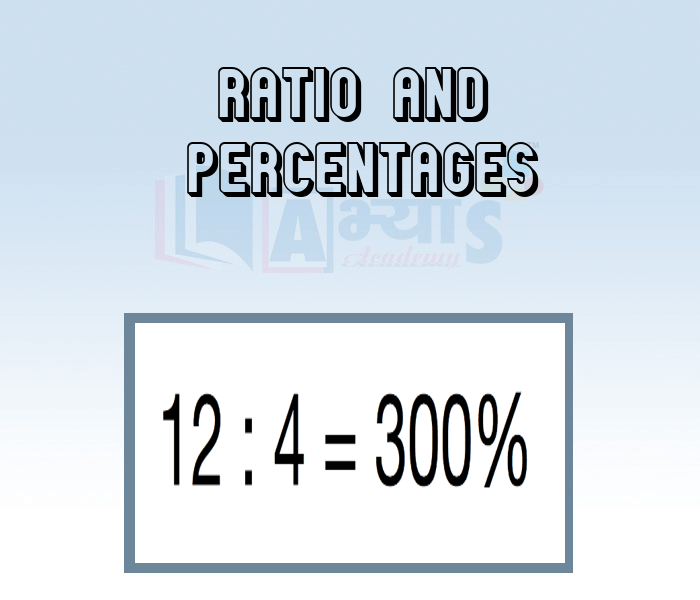Ratio and Percentages








Ratio and Percentages
Ratio and Percentage:
Ratio: The ratio of two quantities 'a' and 'b' of the same kind and in the same units is a fraction which shows that how many times one quantity is of the other and is written as a : b and is read as 'a is to b' where b ≠ 0.
Terms of the ratio: In the ratio a : b, the quantities a and b are called terms of the ratio. Here, 'a' is called the first term or the antecedent and `b' is called the second term or consequent. In the ratio 5 : 9, 5 is called the antecedent and 9 is called the consequent.
Properties of ratio: If the first term and the second term of a ratio are multiplied / divided by the same non-zero number, the ratio does not change.
Ratio in the simplest form: A ratio a : b is said to be in the simplest form if a and b have no common factor other than 1.
Example: Express 15 : 10 in the simplest form.
Solution:
In this we cancelled the common factor 5. Thus, we have expressed the ratio
and the terms 3 and 2 have common factor only 1.
Percentages: The word percent means per hundred.
Conversion of Ratio into Percent:
Example: Convert 3:4 into percent
Solution:
Ratio and Percentage: To express a ratio as percentage we add both the ratios. Then we divide the ratio with the sum of ratios and multiply it with 100.
Example: Express 2:3 as percentage
Solution: First we find the sum of ratios: 2+3 = 5
The divide the first ratio i.e. 2 with 5 and multiply with 100.
The divide the second ratio i.e. 3 with 5 and multiply with 100
Or The second ratio can also be found as 100% - 40% = 60%
Hence, we can express each part of ratio x:y as percentage
Convert 10:40 ratio to percent. | |||
| Right Option : C | |||
| View Explanation | |||
Convert 4.5% into ratio. | |||
| Right Option : B | |||
| View Explanation | |||
Express 18:36 in simplest form. | |||
| Right Option : C | |||
| View Explanation | |||
Students / Parents Reviews [20]
Usually we see institutes offering objective based learning which usually causes a lag behind in subjective examinations which is the pattern followed by schools. I think it is really a work of planning to make us students grab the advantages of modes of examination, Objective Subjective and Onli...

Anika Saxena
8thMy experience with Abhyas Academy has been very good. When I was not in Abhyas whenever teacher ask questions I could not speak it confidently but when I came in Abhyas, my speaking skills developed and now I am the first one to give the answer of teachers question.

Upmanyu Sharma
7thMy experience was very good with Abhyas academy. I am studying here from 6th class and I am satisfied by its results in my life. I improved a lot here ahead of school syllabus.

Ayan Ghosh
8thBeing a parent, I saw my daughter improvement in her studies by seeing a good result in all day to day compititive exam TMO, NSO, IEO etc and as well as studies. I have got a fruitful result from my daughter.

Prisha Gupta
8thAbout Abhyas metholodology the teachers are very nice and hardworking toward students.The Centre Head Mrs Anu Sethi is also a brilliant teacher.Abhyas has taught me how to overcome problems and has always taken my doubts and suppoeted me.

Shreya Shrivastava
8thMy experience with Abhyas academy is very good. I did not think that my every subject coming here will be so strong. The main thing is that the online tests had made me learn here more things.

Hiya Gupta
8thWe started with lot of hope that Abhyas will help in better understnding of complex topics of highers classes. we are not disappointed with the progress our child has made after attending Abhyas. Though need to mention that we expected a lot more. On a scale of 1-10, we would give may be 7.

Manya
8thThird consective year,my ward is in Abhyas with nice experience of admin and transport support.Educational standard of the institute recumbent at satisfactory level. One thing would live to bring in notice that last year study books was distributed after half of the session was over,though study ...

Ayan Ghosh
8thWhen I have not joined Abhyas Academy, my skills of solving maths problems were not clear. But, after joining it, my skills have been developed and my concepts of science and SST are very well. I also came to know about other subjects such as vedic maths and reasoning.

Sharandeep Singh
7thIt was good as the experience because as we had come here we had been improved in a such envirnment created here.Extra is taught which is beneficial for future.

Eshan Arora
8thIt was a good experience with Abhyas Academy. I even faced problems in starting but slowly and steadily overcomed. Especially reasoning classes helped me a lot.

Cheshta
10thA marvelous experience with Abhyas. I am glad to share that my ward has achieved more than enough at the Ambala ABHYAS centre. Years have passed on and more and more he has gained. May the centre flourish and develop day by day by the grace of God.

Archit Segal
7thMy experience with Abhyas academy is very nice or it can be said wonderful. I have been studying here from seven class. I have been completing my journey of three years. I am tinking that I should join Abhyas Academy in tenth class as I am seeing much improvement in Maths and English

Hridey Preet
9thMy experience with Abhyas is very good. I have learnt many things here like vedic maths and reasoning also. Teachers here first take our doubts and then there are assignments to verify our weak points.

Shivam Rana
7thAbhyas is good institution and a innovative institute also. It is a good platform of beginners.Due to Abhyas,he has got knoweledge about reasoning and confidence.My son has improved his vocabulary because of Abhyas.Teacher have very friendly atmosphere also.

Manish Kumar
10thOne of the best institutes to develope a child interest in studies.Provides SST and English knowledge also unlike other institutes. Teachers are co operative and friendly online tests andPPT develope practical knowledge also.

Aman Kumar Shrivastava
10thI have spent a wonderful time in Abhyas academy. It has made my reasoning more apt, English more stronger and Maths an interesting subject for me. It has given me a habbit of self studying

Yatharthi Sharma
10thIn terms of methodology I want to say that institute provides expert guidence and results oriented monitering supplements by requsite study material along with regular tests which help the students to improve their education skills.The techniques of providing education helps the students to asses...

Aman Kumar Shrivastava
10thAbhyas Methodology is very good. It is based on according to student and each child manages accordingly to its properly. Methodology has improved the abilities of students to shine them in future.

Manish Kumar
10thAbhyas academy is great place to learn. I have learnt a lot here they have finished my fear of not answering.It has created a habit of self studying in me.The teachers here are very supportive and helpful. Earlier my maths and science was good but now it has been much better than before.
